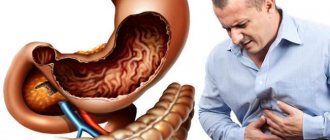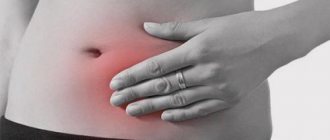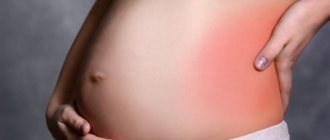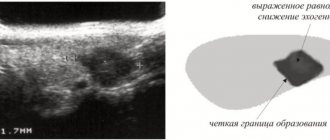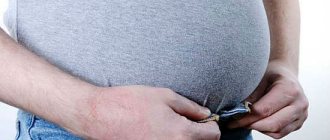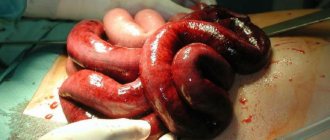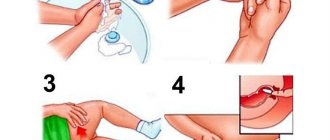Pain in the lower abdomen in women on the left or right, which has an incomprehensible nature, is the most common problem with which they turn to a gynecologist. In fact, such pain can indicate both organic and functional disorders of the life support system. Quite often there is a need to consult doctors of other profiles. Unusual pain in the abdomen can occur due to spasms of the muscles of internal organs or when inflammatory processes begin in them.
What kind of pain is there?
Women with unilateral gynecological pathology most often complain of dull pain. During inflammatory processes, it is also usually dull, the temperature rises, and the woman feels general weakness. If purulent pathologies develop, the pain can be nagging. In the presence of cancer and its progression, the pain will intensify, this is due to the fact that the tumor puts pressure on the nerve endings.
Sharp pain usually occurs when the intestines are bursting with gases. It may indicate the development of acute expansion of the renal pelvis, appear after rupture of ligaments or damage to the ovary, or when stones pass through the urinary tract. Stitching pain indicates the development of intestinal or kidney diseases. This could also be problems with the lower back, cartilage or joints; it may indicate that the cyst will rupture soon.
If a woman’s lower left abdomen bothers her or her stomach often hurts, this may indicate the presence of serious disturbances in the functioning of the body. Therefore, if this bothers you often or does not go away for a long time, you should definitely consult a doctor, conduct appropriate examinations, establish the cause of such symptoms and begin effective treatment.
Treatment of groin pain in women
To treat groin pain, a woman should follow a strict diet. Exclude fried, flour, sweet, salty and smoked foods from the menu. Eat plant-based foods. Limit your intake of fats and carbohydrates. Steamed fish and meat, fruits and vegetables are suitable. Be sure to drink clean drinking water. Salt should be excluded, as pain in the groin may indicate kidney problems. It is advisable to include physical therapy and massage in your daily routine after a doctor’s prescription.
Drug treatment should not be started without visiting a doctor. At the KDS Clinic you will be referred for blood, stool, urine and biochemistry tests. It is necessary to do an ultrasound diagnosis of the pelvic organs. In some cases, magnetic resonance imaging is used to obtain a clearer effect, however, this procedure has a number of contraindications. It is prohibited:
- Children under sixteen years of age. The child’s body is not yet strong, so the radiation will damage healthy organs.
- Pregnancy. During pregnancy, magnetic resonance imaging is strictly prohibited. It will harm the development of the fetus.
- Lactation period.
Causes of pain
The formation of sharp pain in the lower abdomen on the left side usually indicates the development of serious pathologies of the most important organs:
- acute form of pancreatitis;
- cystitis;
- increase in bladder size;
- kidney inflammation;
- Giardiasis.
Experts distinguish between physiological and organic causes of tingling in the lower abdomen. The first include excessive gas formation in the intestines, restructuring of the muscular system during pregnancy in the last trimester, an increase in daily physical activity, the onset of the menstrual cycle, etc. As a rule, such pain is completely natural and does not require seeking medical help, because pass over a short period of time.
More serious are organic causes caused by the development of diseases of internal organs in a woman’s body. Most often, when patients present with stabbing pain in the lower abdomen, doctors diagnose:
- disturbances in the functioning of the organs of the reproductive system - ovaries and uterus, development of cysts, proliferation of connective tissues, etc.;
- diseases of the excretory system and digestive tract, the development of inflammatory processes due to infection, hypothermia and other reasons;
- consequences of using mechanical contraceptives;
- Ectopic pregnancy
- disturbances in the process of conception and the course of pregnancy development - fetal death, placental abruption, ectopic pregnancy.
Depending on the causes of occurrence, stabbing pain in the lower abdomen in women has a different character and intensity. The pain can be sharp or barely noticeable, dull and aching, reminiscent of labor pains, stabbing, spreading throughout the body like waves, precisely localized or vague, etc.
The second indicates a malfunction of some organ during pregnancy, menstruation, ovulation, etc.
Table 1. Common causes of pain
| Cause | Consequences |
| Inflammation | Ulcers, erosions, appendicitis, gastritis, diverticulitis, cholecystitis, inflammation of the colon, cystitis, gastroenteritis, pyelonephritis, colitis. |
| Disorders of the vascular system | Thromboembolism, aneurysm, blockage, anemia. |
| Peritonitis | Bacterial infection, pancreatitis, serositis, abscess, intestinal infarction, diverticulitis, chemical irritation. |
Causes of pain in the lower abdomen
The main causes of pain in the lower abdomen are as follows:
- Menstruation. Pain during menstruation is called dysmenorrhea. Dysmenorrhea can be primary (passes with the end of menstruation) and secondary (occurs against the background of an inflammatory process).
- Gynecological inflammatory diseases (adnexitis, endometritis, salpingitis, etc.). Most often accompanied by severe, aching pain that regularly bothers you. Other symptoms also appear, such as heavy discharge, a constant urge to urinate, a burning sensation and itching.
- Malignant formations;
- The presence of an ovarian cyst and symptomatic uterine fibroids;
- Endometriosis (a disease that damages the internal tissue of the uterus - the endometrium);
- Abortion;
- Consequences of inserting an intrauterine device.
Gynecological diseases in women
Pain in the lower left is a sign of a possible gynecological problem. There are a number of pathologies that manifest themselves with just such symptoms.
Inflammation of the appendages and uterus
Occurs due to infection. This often happens through the reproductive system (during sexual intercourse without proper protection). Freezing and hypothermia also occur. Patients complain of pain in the lower abdomen, which tends to become pronounced during sexual intercourse and urination. In this case, the stomach looks like a drum, and the temperature reaches 38C. In addition to the entire clinical picture, pus is released from the vagina, and sometimes bleeding. It is necessary to conduct an MRI and ultrasound. This disease is treated simply: analgesics, electrophoresis, Declofenac, antibiotics, and in advanced cases, the affected tissue is removed.
Ectopic pregnancy
A severe gynecological pathology that develops when a fertilized egg enters the uterine cavity (into the fallopian tube, ovary, abdominal cavity). Such a diagnosis can be suspected if the patient indicates frequent pain in the lower abdomen, localized in the groin and having the nature of attacks. The same pathology may be indicated by acute pain that occurs when a pipe ruptures. The pain tends to spread to the vagina, rectum and area above the collarbone.
In this case, there is a delay in menstruation and a positive pregnancy test. Bloody discharge may occur during an attack. Ectopic pregnancy leads to intracavitary bleeding and is an indication for emergency surgery. Women who have already had similar complications, have diseases of the genital organs and intrauterine devices are at risk for this disease.
Cystosis
The formation of cysts on the organs of the reproductive system is also a common disease that causes a pain symptom, which, as a rule, is mildly aching in nature. Often the cause of their formation is a hormonal imbalance, which becomes more frequent:
- during pregnancy;
- during menopause;
- in adolescence.
The pathology is dangerous because it develops without symptoms for a long time, and the woman does not even suspect that a cyst formation has begun inside the organ.
If the cyst is not detected in time or is not treated, complications may develop such as:
- cyst rupture;
- intra-abdominal bleeding;
- torsion of the cyst pedicle;
- peritonitis;
- degeneration of a cyst into a cancerous tumor.
The main symptoms of the late stage of cyst development:
- Discomfort and nagging pain in the lower abdomen.
- Disorders of the gastrointestinal tract.
- Bloating.
- Hair coarsening.
- Increased frequency of urination, pain, pain during urination.
Polycystic ovary syndrome
An increase in the size of the ovary due to multiple cystic formations often occurs due to malfunctions of the endocrine system, hormonal disorders, and neurological diseases.
The disease may not manifest itself for a long time and develop into dangerous diseases such as infertility, type 2 diabetes, vascular atherosclerosis and uterine cancer.
Therefore, it is important to identify pathology in time. Preferably at an early stage of development, for this you need to come to see a doctor, even if nothing is bothering you yet.
Endometrial polyp
This is a benign formation on the inner lining of the uterus. Polyps arise due to malfunctions of the endocrine and immune systems, hormonal disorders, metabolism in the body, etc.
Women usually become aware of the disease at a later stage of development, when pain symptoms occur, particularly in the left side of the lower abdomen. This symptom may be accompanied by:
- spotting brown discharge;
- irregularities in the menstrual cycle;
- intoxication: nausea, fever, weakness, etc.
Externally, this disease is very similar to a malignant tumor. And only timely diagnosis will help establish the type and nature of the neoplasm in a woman’s body.
Cervical erosion
An erosion or ulcer in the vaginal part of the cervix also causes pain in the lower abdomen on the left.
The causes of the pathology can be operations and abortions, early and promiscuous sex life, reduced immunity, addictions, and so on.
Sometimes it develops without symptoms, and the ulcer grows quickly and can develop into a malignant tumor. An examination by a gynecologist is the only way to detect and treat cervical erosion.
The disease manifests itself with mucous or bloody discharge.
Premenstrual syndrome
Every woman knows the state of increased nervousness and nagging pain in the lower abdomen a few days before the onset of menstruation. This symptom can be simply unbearable if women have suffered:
- operations and abortions;
- difficult childbirth;
- infectious diseases;
- frequent stress, overwork.
At this time, the stomach may hurt in any part of it, the lower back, or the back. Swelling and dizziness, increased irritability and depression, frequent or difficult urination, constipation or diarrhea, etc. appear.
Why does the stomach feel tight in the early stages of pregnancy?
Why does the stomach feel tight in the early stages of pregnancy? This question often worries expectant mothers, and at times leads to panic. When is discomfort pathological and when is it normal?
Pregnancy is a special time for a mother and her baby. After all, the connection between them is inextricable, and every negative influence or stress affects both of them.
Possible causes of pain
Every woman dreams of pregnancy being easy and not causing any cause for alarm. However, a very common complaint among pregnant women is pain in the lower abdomen of a pulling or aching nature.
Complaints are so common that it is necessary to clearly understand when pulling sensations during pregnancy are pathological and require immediate medical intervention, and when they are completely physiological and require only compliance with general recommendations.
Of course, pain in the lower abdomen can appear at any stage of pregnancy, however, most often women note their appearance in the early stages of pregnancy.
Painful sensations in the abdomen during pregnancy are very diverse, both in subjective sensations and in their localization and intensity of occurrence. Pain can appear both at rest and after any physical activity. Unpleasant sensations may appear in one place or radiate to other areas.
Unpleasant sensations in the lower abdomen can rarely be avoided during pregnancy. These sensations can occur not only with pathology. During pregnancy, the uterus increases in size, and its ligaments and muscles are stretched. In addition, displacement of the pelvic organs occurs. All this leads to the appearance of pulling or aching sensations in the abdomen. All these phenomena are manifestations of physiological changes that occur to a woman during pregnancy.
Of course, this condition does not cause concern and does not require any intervention from a doctor. However, nagging pain in the lower abdomen is not always a physiological process. It happens that this indicates that the pregnancy is pathological and requires medical adjustment.
That is why, if you experience nagging or aching pain in the lower abdomen, you need to contact an obstetrician-gynecologist to accurately determine the cause of the pain.
Never self-medicate. Remember that you are responsible not only for yourself, but also for the little man you carry under your heart.
Abdominal pain during pregnancy can be:
- "obstetric";
- "non-obstetric".
Pain associated with pregnancy may be related to the development of:
- physiological changes during pregnancy;
- threatened miscarriage;
- frozen pregnancy;
- ectopic pregnancy.
Pain not associated with pregnancy may occur with:
- inflammatory processes;
- pathologies of the digestive system;
- surgical diseases;
- diseases of other organs or systems.
Pain in the lower abdomen during pregnancy as a normal option
Not all pain in the lower abdomen during pregnancy is a manifestation of pathology. Sometimes they can occur during normal pregnancy.
As a physiological process, pain in the lower abdomen can occur in the following situations:
- a sign of pregnancy;
- displacement of the pelvic organs by the growing uterus;
- sprains of ligaments and muscles associated with the growth of the uterus.
Abdominal pain is a sign of pregnancy
Finding out that you are pregnant is not difficult nowadays because there are pregnancy tests. In addition, a delay in menstruation can serve as evidence of pregnancy.
All this is good if menstruation is regular and the delay is at least 14 days. In this case, the pregnancy test may be positive. However, do not forget that not all tests are highly accurate, so it may show two cherished stripes much later than we would like.
Therefore, it is necessary to pay close attention to the sensations of your body, because it signals the onset of pregnancy long before the appearance of a delay in menstruation.
If you think that pregnancy is possible, then listen carefully to your body: it may send you a signal in the form of nagging pain in the lower abdomen. In this case, the pain will differ in its intensity: one woman will say that the pain is unbearable, another will not notice it at all. Every woman is individual.
If each menstruation is preceded by unpleasant painful sensations in the lower abdomen or lower back, you may not understand that once again they are associated with the onset of pregnancy.
Pain in the lower abdomen during pregnancy may be associated with the implantation process. To do this, it is necessary to recall the process of fertilization of an egg by a sperm. After their fusion in the fallopian tubes, the fertilized egg enters the uterus under the influence of the movement of cilia in the fallopian tubes. The uterine endometrium is a loose mass into which a fertilized egg is implanted.
The implantation process is the introduction of a fertilized egg into the endometrium of the uterus. At this time, a violation of the integrity of the endometrium occurs, which may be accompanied by unpleasant sensations in the lower abdomen. In addition, sometimes slight spotting dark bloody discharge may appear from the genital tract, which can be perceived as the beginning of another menstruation.
Threatened miscarriage
A fairly common reason for pain in the lower abdomen is a threatened miscarriage. This condition is individual and does not depend on physical activity or complete rest, but on the condition of the woman and her unborn child.
Reasons that can cause a miscarriage include:
- heavy physical activity;
- sexual contact;
- nutritional disorders of the ovum;
- genetic disorders and other reasons.
Of course, this is not evidence that with complete rest a miscarriage will not occur. Miscarriage can occur due to genetic abnormalities and stress. No woman is immune from the threat of pregnancy loss.
That is why it is so necessary to pay attention and be sensitive to the state of your body, which will send signals in every possible way that pregnancy is not proceeding as desired.
A threatened miscarriage is accompanied by:
- aching or nagging pain in the lower abdomen;
- aching or nagging pain in the lower back or sacrum.
- bloody discharge from the genital tract.
If you experience pain in the lower abdomen, you need to consult a doctor, since a threatened miscarriage, if medical care is not provided, can turn into an incipient abortion, the treatment of which is much more difficult, if not completely useless.
An ambulance should be called if:
- pain in the lower abdomen intensifies;
- pain begins to radiate to other areas;
- painful sensations do not go away for a long time;
- bloody discharge from the genital tract appeared.
Increased pain
If the nagging pain in the lower abdomen is weak, does not intensify and does not radiate to other areas, then you can come to the antenatal clinic in the daytime on your own. This will not cause serious complications to your condition.
If the painful sensations become more intense and do not go away with rest, you should not self-medicate or take medications without a doctor’s prescription.
You can't put anything on your stomach. Both hot and cold application can contribute to the onset of miscarriage. In addition, if there is a threat of abortion, this manipulation will not remove painful sensations.
Localized pain
If a threatening miscarriage occurs, a pulling or aching pain bothers the pregnant woman in the lower abdomen.
If the pain is clearly localized in a specific place, most often on the right or left, then a mandatory consultation with a specialist is necessary, since the development of an ectopic pregnancy or surgical pathology, for example, appendicitis, is possible.
Bloody discharge from the genital tract
If the nagging painful sensations in the lower abdomen are accompanied by bloody discharge from the genital tract, urgent medical attention is needed. This phenomenon may indicate an ongoing miscarriage.
The discharge can be scanty, spotting or abundant, dark or bright. In any case, you cannot do without consulting an obstetrician-gynecologist.
There are situations when there is no pain, but there is bloody discharge from the genital tract. This case also requires specialist consultation.
Any bloody discharge from the genital tract may be evidence of an incipient miscarriage. Only timely treatment can help maintain and prolong pregnancy.
In some cases, the appearance of bloody discharge from the genital tract may be a manifestation of a frozen pregnancy, which requires immediate medical intervention.
Frozen pregnancy
The fertilized egg does not always develop correctly. In some cases, its division stops and it dies. Most often, a frozen pregnancy due to some mutations. In this case, the woman does not suspect that the pregnancy has stopped.
However, the dead fertilized egg begins to be rejected on its own. In this case, nagging pain occurs in the lower abdomen, which is soon joined by bloody discharge from the genital tract.
When diagnosing a frozen pregnancy, curettage of the uterine cavity may be indicated. Conservative management is also possible, but this can only be determined by a specialist after consultation.
Ectopic pregnancy
Ectopic pregnancy most often occurs as a tubal pregnancy, when the fertilized egg does not reach the uterus, and the implantation process occurs in the fallopian tube. In this case, the development of the fertilized egg can continue for a long time without any manifestations, up to 12 weeks of pregnancy. However, most often such a pregnancy is terminated at 6–8 weeks.
The fertilized egg develops and grows, which causes pain in the right or left side of the lower abdomen. The pain is one-sided, obsessive in nature, and tends to intensify.
In addition to pain in the lower abdomen, bloody discharge from the genital tract appears, and pain begins to radiate to the leg from the side where the pain appears. There may be unpleasant sensations of pressure on the rectum. Medical surgery is the only way to save a woman’s life. Preservation of pregnancy is impossible in this case.
“Non-obstetric” causes of pain in the lower abdomen
Inflammatory processes
Among the “non-obstetric” causes that cause nagging pain in the lower abdomen, the most common are inflammatory processes of the pelvic organs. If previously it was believed that inflammation could not occur in pregnant women, now it has been proven that a decrease in the immunity of a pregnant woman awakens all pathological processes in her body.
Pain during inflammatory processes of the pelvic organs varies in intensity. In this case, they arise in the lower abdomen and most often have a pulling or aching character.
Pathology of the digestive system
Very often, nagging pain in the lower abdomen can occur in a pregnant woman due to problems with the digestive tract. During pregnancy, intestinal contractility decreases. In addition, significant changes occur in a woman’s hormonal background. Therefore, very often pregnancy is accompanied by constipation and bloating. To normalize digestion, it is recommended to change the diet and take mild laxatives.
Surgical pathology
Of the surgical pathologies that may be accompanied by nagging pain in the lower abdomen during pregnancy, the most common is acute appendicitis.
In the early stages of pregnancy, it is necessary to differentiate obstetric and gynecological diseases from appendicitis, since it has similar symptoms. Pain appears in the lower abdomen, which most often occurs in the navel or stomach, and then descends to the right iliac region. Nausea and vomiting occur, and the temperature rises. The only treatment method is surgery. In this case, the pregnancy continues.
Diseases of other organs or systems
In addition to obstetric and surgical reasons, which can cause nagging pain in the lower abdomen in the early stages of pregnancy, other body systems can also be involved in the pathological process. The most common lesion is the genitourinary tract.
Cystitis
Cystitis, due to the anatomical features of a woman, can occur at any time and in any condition, so pregnant women are just as susceptible to it as non-pregnant women.
The bladder, located in the lower third of the abdomen, can give false symptoms of a threatened miscarriage.
Cystitis, in addition to nagging or aching pain in the lower abdomen, is accompanied by pain when urinating, pain at the end of urination. In addition, with cystitis, the urine may be stained with blood, and it is difficult to distinguish this from spotting during a miscarriage.
In any case, it is necessary to consult an obstetrician-gynecologist, undergo a general urine test, and then consult a urologist and treat the infection. Any infection can negatively affect the condition of the fetus, so timely treatment is the key to the normal development of your child.
Making an appointment with a gynecologist
To clarify the details, consult a qualified specialist at the Semeynaya clinic.
Single contact center
8 495 662-58-85
weekdays 8-21, weekends 9-21
To clarify prices for an appointment with a gynecologist or other questions, follow the link below:
Gynecology
Problems and diseases of the gastrointestinal tract
Proctitis
This is an inflammation of the rectal mucosa. It can occur due to various circumstances: after mechanical impact on the rectum, due to a sedentary lifestyle, after infectious diseases, in the presence of chronic diseases, infection with parasites, etc.
Pain in the rectum, which can radiate to the left lower abdomen, is accompanied by constipation and discharge from the anus. Only a professional proctologist can identify the disease and treat it correctly. Therefore, do not delay treatment, make an appointment with specialists.
Pancreatitis
As a rule, the presence of stones in the bile ducts provokes another disease, which can also be expressed by pain in the lower left - this is pancreatitis - inflammation of the pancreas. The stones block the ducts, which provokes the accumulation of enzymes secreted by the gland to digest food. If the process is not stopped, then these enzymes are converted into a harmful secretion, which begins to digest the walls and tissues of the pancreas itself. This causes acute pain in the left side of the abdomen. Acute pancreatitis begins, which has a number of characteristic signs:
- diarrhea or constipation;
- dry mouth;
- bloating;
- nausea and vomiting.
If you have pancreatitis, you should eat right and follow a diet. We will tell you how to properly create a diet in our special article.
For any symptoms, you should urgently call an ambulance, as pancreatitis can turn into purulent necrosis and cause general intoxication and blood poisoning.
Pathologies of the spleen - lymphocytic leukemia and myeloid leukemia
These are cancer diseases that manifest themselves as pain in the lower abdomen. When the tumor develops and increases in size, it can cause blockage of the arteries, then the pain on the left intensifies. Volvulus of the spleen also causes pain on the left side, which is complemented by symptoms - fever, bloating, nausea and vomiting. Purulent inflammation may develop, which is life-threatening. Identifying pathology at an early stage means having a chance to recover from this serious illness.
Haemorrhoids
The most common proctological problems in women include hemorrhoids. The appearance of hemorrhoids in the anus causes pain, which can be localized in the left lower abdomen. The pathology is provoked by a sedentary lifestyle, childbirth, surgery, heavy lifting, unhealthy diet, etc. Additional signs may include:
- pain during bowel movements;
- bleeding from the anus;
- itching, burning;
- frequent constipation.
You should not endure the symptoms, since the advanced stage of this disease can even provoke cancer.
Appendicitis
The causes of spasms may also be associated with an attack of appendicitis. It should be taken into account that this disease begins with an increase in temperature and pain, which is first felt in the epigastrium, and then in the iliac region. In addition, there is intoxication, weakness, vomiting, sometimes diarrhea, and loss of appetite.
The pain in the iliac region is sharp, however, its intensity can vary - sometimes it is constant, sometimes it is intermittent pain. It starts in the center, gradually shifts to the right side, intensifies when moving, when coughing, when a person changes body position. At the very beginning of the development of such symptoms, it is important to consult a doctor, since without timely surgical intervention, peritonitis and death are possible.
Cholecystitis
Most often, inflammation of the gallbladder occurs if there are stones in it. The course of the disease is acute - there is a stabbing pain in the lower back and lower abdomen, the temperature rises, the person feels nauseous, and is bothered by itchy skin as a consequence of increased bilirubin. It hurts in the right groin in women, in the lower abdomen, in the right hypochondrium, it radiates to other organs: the back hurts, it radiates to the lower back. The discomfort becomes more pronounced after eating. For cholecystitis, the doctor prescribes a diet and medications that activate the flow of bile. If the stones are large, there is no other treatment method other than surgery.
Pyelonephritis, cystitis
The causes of such ailments are associated with infection in the urinary tract. With an inflammatory process in the bladder, acute pain develops in the groin area, which becomes more acute when urination occurs. Sometimes it is very difficult for a woman to pee, since this process cuts a lot.
Both pyelonephritis and cystitis are treated with antibiotics, as well as nitrofuran drugs. During an ectopic pregnancy, the fertilized egg is implanted outside the uterine cavity (this can be the ovary, abdominal cavity, fallopian tube). In this condition, a woman with a tubal abortion experiences periodic pain in the groin area. Paroxysmal pain, as before or during menstruation.
Prevention measures
The best preventive measure is timely contact with a specialist. It is much easier to treat the disease at an early stage. This will minimize the likelihood of complications. To prevent the re-development of intestinal diseases, you will need to follow a diet.
Usually it is enough to adhere to proper nutrition standards. Prevention of cystitis and diseases of the urinary system usually consists of maintaining good hygiene. Additionally, it is recommended to visit a gynecologist at least once every six months. Most gynecological diseases at an early stage are asymptomatic. Noticing them on your own is quite problematic.
Pregnancy should be completely under the supervision of a doctor. You need to register in a timely manner. A woman must undergo all preventive examinations. You should not refuse hospitalization, even if the doctor recommends it for preventive purposes or in case of a minor threat. In any case, it is better not to relieve pain, but to prevent it. To do this, you need to follow simple rules of hygiene, strengthen your immune system, engage in moderate physical activity, especially during sedentary work, adhere to a healthy lifestyle and monitor your diet.
